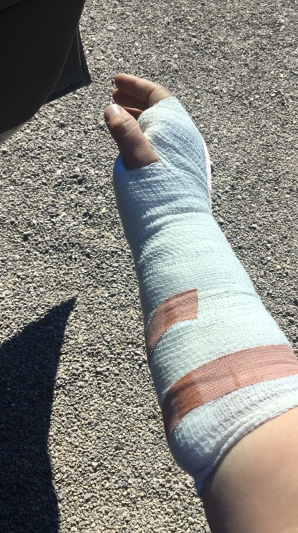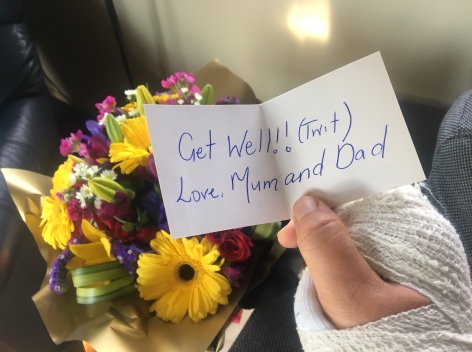Back in 2013 I wrote a post about an accident I had with a horse which resulted in two broken metatarsals (the long bones in your foot). That post was about how healing takes time, and indeed, my foot did heal with time and patience.
Alas, it’s time to remind myself, again, that healing takes time…
![IMG_0394]()
- Goofing around on that fateful day…
A few weeks ago I was out mountain biking with a friend. The irony of the story is that while we pushed ourselves to try out some new skills and sessioned a jump for a while, it was the relatively tame trail back to the car that had me hit the dirt. I can’t tell you what happened (I didn’t hit my head, thank goodness, I just have no idea what happened!) but as my hip and fist collided with the packed earth I was acutely aware that I’d broken something in my hand. In fact, my first words were “I’ve broken my hand” (repeated 3-4 times).

My X-rays from 2013 needed arrows for emphasis. No arrows needed here: Spiral fracture of the 5th metacarpal and fracture at the base of the proximal 4th phalynx.
The doctor who saw me in the local Urgent Care was confident that I could continue working with my injury. Sure- I couldn’t suture or do some specific physical exam maneuvers, but otherwise I shouldn’t be too limited; at least that’s what he thought. Looking back on it, it wasn’t a smart decision to work with a bulky splint on my freshly-broken dominant hand. Yes, my brain was fully functional, but I could only examine patients using one hand, could only type with one hand, and had to use my left hand to use the mouse and navigate my computer (a task that required a surprising amount of focus- I couldn’t “drive” my computer and listen to a patient at the same time). Despite adding in some extra breaks and a brief stint having a nurse work in parallel with me it became obvious that I couldn’t carry on with work as usual.

When my patients saw me in this they often said “It looks like you need a doctor more than I do!”. Another classic was “You’ve been in the wars!”.
While I’ve working in the New Zealand medical sector for just over a year, this has been my first experience as a patient.
In my last post I wrote a bit about the healthcare system in New Zealand, but I didn’t mention how it’s all paid for and provided. I am no expert on the NZ health system, and the whole system is certainly more complex that I could (or should) spell out in a blog post, but the core organizations are the DHB (the district health board) which uses government funds to provide health care, ACC (the Accident Compensation Corporation) which is New Zealand’s Universal no-fault accident insurance scheme, and some private coverage (either paid out of pocket by patients or by optional additional health insurance).

The DHB pays for medical care which is needed as a result of illness while ACC pays for medical care (and more) that is needed as a result of injury. The DHB only covers healthcare for citizens and those with working visas 2-years in duration, so if you are travelling (or working in NZ for less than 2 years) and become unwell you are financially responsible for your own medical expenses. ACC, however, covers everyone in New Zealand. If you are travelling in New Zealand and injure yourself you have access to healthcare through ACC. You may have to pay co-pays (For example $35+ for a GP or urgent care visit, $45 for an X-ray, and $20+ for physio visits), but if you have a massive accident requiring a helicopter ride and a prolonged ICU stay, you won’t get a bill…
ACC doesn’t just cover medical expenses, it also functions as disability insurance. If you can’t go to work due to an injury, they will compensate you at a rate of 80% of your normal income after one week. If you can go back to work part time they will help subsidize your until you are recovered and back to full time work. They have return-to-work programs, and try to get people back into the workforce in whatever capacity and quantity they are able.
ACC helps with other things: if you can’t drive they can provide taxis, if you can’t keep up with your daily tasks they get you in home help, if you need physio and strengthening they subsidize therapies and gym memberships, if you need counseling they cover that.
Essentially, ACC is a massive, national, accident insurance policy that is paid for by levies placed on employers, workers, and vehicles. Does the system have flaws? Certainly, what system doesn’t? There are people who defraud the system, and people will complain about declined coverage, but as a clinician and now a client I am very impressed with the system.
The day after my injury I was seen at urgent care where I paid $120NZD to be seen (this would be much less if I had a 2-year visa and was thus entitled to healthcare in NZ) and $45 for an X-ray. I then had a splint put on and a week later went back in for repeat X-rays, evaluation, and a more permanent splint at no additional cost. I’ve since seen the hand therapist and visited a physio twice because of a pain in my hip that wasn’t settling with time- both with a reasonable co-pay. I worked for a week with my initial injury, but came to realize that I wasn’t able to doctor one handed and in a splint, so after talking with my boss it was decided that I’d be off work while I was in my current splint and limited to the use of my non-dominant hand. ACC promptly recognized my claim and called me to see if I needed help getting to appointments, help around the home, and what was appropriate compensation while I couldn’t work (information based on last year’s tax return). Thinking about what my ACC levy was last year and what it’s likely to be this year I suspect I’ll get about as much out of ACC as I put in. I’d be very happy if I hadn’t had to use their services, but I’m incredibly glad that a national accident insurance exists in NZ*.
I’ve extended my time in New Zealand through March but plan to return to the United States to work and live after that. As I start to mentally prepare myself to return to the US and think about working in a for-profit healthcare system, I find myself already missing the public health system in NZ.
5 years ago, when I broke my foot, even though I had medical insurance I ended up owing over $2000 out of pocket for a single, simple, medical encounter.
For one medical encounter where I was evaluated, X-rayed and given a walking boot and crutches the total bill was well over $5000USD. The old orthopedist who walked in and said “Doctor, heal thyself!” sent a bill for $2479, including global billing codes for evaluation and treatment of 2 fractured metatarsals (at $1027 a pop, or perhaps I should say a hair-line crack), despite needing no treatment other than protection in a medical walking-boot. My foot healed with time, and my hand will heal with time, but it is high-time that the US figures out how to provide affordable healthcare for its people.
(*This also has huge implications in “Treatment Injuries” and physicians are not sued for huge sums as they are in the US in the case of adverse outcomes, but that is more than I care to go into today!)

My dad writes good get-well cards…
